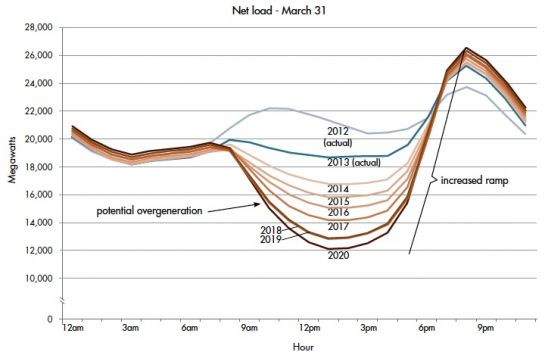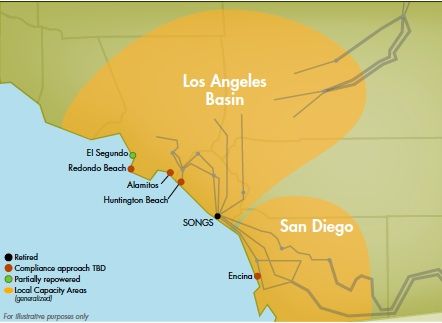California, a state facing an unprecedented challenge in balancing its growing share of intermittent solar and wind power supply on the grid, is turning to wholesale and retail electricity customers for help.
But can the state that leads the nation in energy efficiency also create systems to get millions of residents and thousands of big power users to save power when the grid needs it the most?
That’s the task that the California Independent System Operator has set out in its Demand Response and Energy Efficiency Roadmap (PDF). The 27-page document released last month lays out a four-track plan for a wide array of changes in state energy policy from now to 2020, aimed at turning energy efficiency and demand response into “integral, dependable and predictable resources” for a grid that’s both green and stable.
That’s a challenge, both on a statewide level and within specific regions of the state. It will also require a significant collaborative effort between California ISO and other state energy authorities, including the California Public Utilities Commission (CPUC) and the California Energy Commission (CEC), to create new market mechanisms to bring the two sides of the supply-demand equation into balance.
These new mechanisms, in turn, will need to be aligned with a host of state initiatives, including California’s 1.3-gigawatt energy storage mandate, its push to mandate “smart inverter” features for its solar installations, and the host of electricity tariff, solar net metering and distribution grid planning changes that are coming as the result of last year’s passage of AB 327.
So how does California's ISO envision this wholesale adaptation of the state’s energy policies to the challenges of the grid edge? Here’s an overview, broken down into several key “pathways” laid out in its report.
1) The Load Reshaping Path: Turning DR and EE Into Grid Resources. The first part of the ISO’s roadmap deals specifically with the demand side of the supply-demand equation -- in other words, enlisting customer energy use as a reliable resource for the grid. Consider it a blending of traditional efficiency, which seeks to lower overall energy consumption, and demand response, which specifically targets peak power demand, in a fashion that helps balance the unique characteristics of the state’s increasing share of solar and wind power.
California gets about one-fifth of its power from renewable sources today, and is set to increase that to one-third by 2020. But the solar and wind power that makes up the vast majority of that renewable supply comes with predictable (but disruptive) daily generation peaks and valleys, and with more unpredictable variability linked to the vagaries of wind, sun, cloud cover and coastal fog.
One unique challenge on this front is not only reducing electricity consumption (i.e., the traditional demand response model), but also absorbing excess power. The most well-known example of this problem comes via the “duck curve” graph, which shows how the state’s growing share of solar PV can over-generate during mild spring days, leaving the state’s generation resources with a huge “ramp” in generation to cover late afternoon peak demand:

California ISO suggests a set of locational and time-varying market signals to encourage plug-in electric vehicles, energy storage systems or fast-responding electric loads to use more energy during those times. Resources that can also discharge power to the grid when it’s needed later in the day, like energy storage, could be even more valuable.
This kind of location- and time-specific pricing will need more sophisticated demand response programs that take grid reliability, not just peak demand reduction, into account. The ISO’s existing Participating Load and Proxy Demand Resource products allow load-serving entities (i.e., utilities) and demand aggregators, respectively, to play into the state’s grid markets. A third program under development, the Reliability Demand Response Program, could give the state’s emergency DR programs a role in grid markets as well.
But California’s rules still don’t offer as much opportunity for demand response as do other grid regimes, like that run by mid-Atlantic grid operator PJM, which allows demand response assets to bid into capacity markets and get paid immediately for pledging resources to be made available in future years. (For a breakdown of the state’s specific demand response regulatory challenges, read pages 47-48 of CEC’s 2013 Integrated Energy Policy Report [PDF].)
Matching customer-side energy management to grid needs will also require more analysis of how different energy efficiency programs change the “load shapes” of the regions in which they’re applied. California ISO notes that measures such as combining smart-grid-enabled automation, changes in retail electricity tariff rates, and the use of emergency conservation programs when the grid is under extreme stress will all be needed in the long run. These are all parts of the wide-ranging changes in electricity tariffs ordered by the passage of AB 327 -- but just how the CPUC and other parties turn the law’s broad mandates into real-world energy tariffs and programs is a challenge for the coming years.
2) The Resource Sufficiency Path: Creating the Right Mix of Flexible and Local Supply. The second path on California ISO’s roadmap deals with demand response as one of several supply-side resources that can help balance the renewable-powered grid. Two key characteristics help differentiate this new breed of resource from those the state has defined in the past: flexibility and locational value.
Flexible capacity, simply put, is a measure of how quickly and effectively a grid resource can react to the renewable-powered grid’s emerging needs. The ISO defines three key measures of flexibility: “1) steep system ramps in either upward or downward direction, which may vary by month or season and occurs multiple times a day; 2) severe intra-hour system variability in either the upward or downward direction, which may vary by month or season; and 3) second-to-second regulation service to maintain standard frequency,” also known as frequency regulation.
While California has mechanisms in place that allow generators to meet four-second frequency response signals and five-minute “load-following” dispatches, it has organized these markets in ways that differ from -- and some observers say, insufficiently incentivize -- their economic competitiveness in the state’s energy market.
As for continuous ramping -- the kind of capability that’s needed to manage the “duck curve” -- the CPUC in June established an interim framework (PDF) for making multi-hour flexibility an attribute for the state’s resource adequacy mechanism, which is similar to the capacity markets run by grid operators in other parts of the country. CPUC defines this as “the quantity of resources needed by the California ISO to manage grid reliability during the greatest three-hour continuous ramp in each month,” and will require utilities to report how much of this capacity they have in 2014 and start including it in new procurements in 2015.
California’s energy planners see the first and most pressing need for flexible capacity in the swath of Southern California under stress from a double whammy of lost generation: the long-expected closure of gas-fired power plants that use once-through cooling systems and the unexpected closure of the San Onofre nuclear generation station (SONGS) this summer. Southern California Edison is the utility most affected, but San Diego Gas & Electric is also under pressure from the loss of San Onofre -- and that’s led to a host of efforts to find ways to bring demand-side resources into the solution.

The first is coming via SCE’s goal to add 1,400 megawatts to 1,800 megawatts of grid capacity in the region by 2020. This “Local Capacity Requirement Request for Offer,” or LCR RFO, includes a first-ever mandate to include at least 50 megawatts of energy storage to the mix, and it also calls for at least 650 megawatts of “preferred resources,” which means renewable power, energy storage, efficiency or demand response. Stay tuned for a battle on this front between proponents of traditional natural gas-fired generation and renewable power and energy-efficiency advocates who say the region’s needs can be met without new fossil-fuel-fired generation.
As for how to match a future mix of distributed and centralized generation, storage, and demand reduction capabilities to local grid needs, SCE has set up a “Living Pilot” process that’s giving a whole host of technology providers and policy options a chance to test their capabilities. So far, 54 separate proposals have been submitted as solutions, ranging from large-scale hybrid solar-storage implementations and widespread demand response projects to a host of policy and planning ideas to align customers’ consumption patterns with grid demands.
3) Operations and Monitoring Paths: Turning Ideas Into Real-World Action. Merging demand-side resources and capabilities with an increasingly unpredictable generation mix will bring a new set of variables and uncertainties into how CAISO will manage the state’s grid. That will require a set of rules for how demand response, energy efficiency and other resources are controlled and valued -- and while some of those rules are under the state’s control, others are being imposed from above.
Take FERC Orders 745 and 755, the Federal Energy Regulatory Commission rulings that set new requirements and compensation mechanisms for demand response resources. California ISO is getting ready to launch its Reliability Demand Response Resource (RDRR) tariff, which puts FERC Order 745 into effect in the state, in the spring of 2014. But just how CAISO has structured that program has been a point of contention, with FERC forcing it to change its mechanism in the summer of 2013.
As for FERC Order 755, which provides more money to fast-reacting resources, the ISO is still working out the details for implementing its version of the rules, which could have a significant positive effect on automated demand response’s economic competitiveness in the state.
Meanwhile, CAISO is eager to incorporate smart grid technologies that “offer key capabilities including two-way communication and devices for dispatch and performance measurement,” in order to bring more demand response participation to the ISO market. But it also notes that its current metering and telemetry requirements “have not leveraged the capabilities and new models that new technology enables at a much lower cost,” and the agency says it’s working on changes to those requirements over the next two years.
Balanced against this imperative, however, is the ISO’s need to monitor new demand response and energy efficiency programs to make sure they’re doing what they’re supposed to do for the grid. That’s crucial, since the ISO will be deferring transmission or generation upgrades with the promise that the demand-side alternatives will actually work.
Over the course of 2014, California ISO will be working with the CPUC and CEC on how to measure and verify their effectiveness. Two groups -- the CEC-led Demand Analysis Working Group and the Demand Response Measurement Evaluation Committee (PDF) -- are in charge of this process, which makes their periodic reports and assessments worth keeping an eye on.



